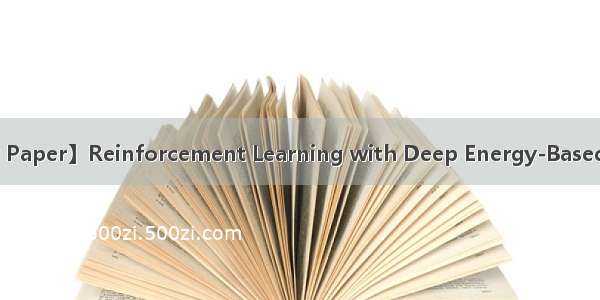
论文题目:Reinforcement Learning with Deep Energy-Based Policies
所解决的问题?
作者提出一种energy-based的强化学习算法,将其运用于连续的状态和动作空间问题中,将其称之为Soft Q-Learning。这种算法的好处就是鲁棒性和tasks之间的skills transfer。
背景
以往的方法是通过stochastic policy来增加一点exploration,例如增加噪声,或者使用一个entropy很高的policy来对其进行初始化。但是有时候我们确实会期望去学一个stochastic behaviors(鲁棒性会更强,具体参见文末扩展阅读)。
那这样的一种stochastic policy会是optimal policy吗?当我们考虑一个最优的控制和概率推断问题之间的联系的话( consider the connection between optimal control and probabilistic inference),stochastic policy可以被视为是一种最优的选择(optimal answer )。(Todorov, )
参考:Todorov, E.General duality between optimal control and estimation. In IEEE Conf. on Decision and Control, pp. 4286–4292. IEEE, .参考:Toussaint, M.Robot trajectory optimization using approximate inference. In Int. Conf. on Machine Learning, pp. 1049–1056. ACM,
直观理解就是,将控制问题作为一个推理的过程(framing control as inference produces policies),目的不仅仅是为了去产生一个确定性的lowest cost behavior,而是整个low-cost behavior。(Instead of learning the best way to perform the task, the resulting policies try to learn all of the ways of performing the task.)也就是我要找到这个问题所有的“最优解”。
这种方法也可以作为一个困难问题的初始化,比如用这种方法训练一个robot向前走的model,然后这个model作为下次训练robot跳跃、奔跑的初始化参数;在多模态的奖励空间中是一种更好的exploration机制(a better exploration mechanism for seeking out the best mode in a multi-modal reward landscape);由于behavior的选择变多了,所以在处理干扰的时候,鲁棒性更强。
前人也有一些stochastic policy的一些研究(参考文末资料),但是大部分都难以用于高维连续动作空间。或者是一些简单的高斯策略分布(very limited)。那能不能去找到一个任意分布的策略分布呢?
作者提出了一种energy-based model(EBM)的方法,energy function为soft Q function。
所采用的方法?
Maximum Entropy Reinforcement Learning
标准的强化学习算法的优化目标为:
πstd∗=argmaxπ∑tE(st,at)∼ρπ[r(st,at)]\pi_{\mathrm{std}}^{*}=\arg \max _{\pi} \sum_{t} \mathbb{E}_{\left(\mathbf{s}_{t}, \mathbf{a}_{t}\right) \sim \rho_{\pi}}\left[r\left(\mathbf{s}_{t}, \mathbf{a}_{t}\right)\right] πstd∗=argπmaxt∑E(st,at)∼ρπ[r(st,at)]
Maximum entropy RL算法的优化目标:
πMaxEnt∗=argmaxπ∑tE(st,at)∼ρπ[r(st,at)+αH(π(⋅∣st))]\pi_{\mathrm{MaxEnt}}^{*}=\arg \max _{\pi} \sum_{t} \mathbb{E}_{\left(\mathbf{s}_{t}, \mathbf{a}_{t}\right) \sim \rho_{\pi}}\left[r\left(\mathbf{s}_{t}, \mathbf{a}_{t}\right)+\alpha \mathcal{H}\left(\pi\left(\cdot | \mathbf{s}_{t}\right)\right)\right] πMaxEnt∗=argπmaxt∑E(st,at)∼ρπ[r(st,at)+αH(π(⋅∣st))]
其中α\alphaα是衡量reward和entropy之间的权重系数。与以往的Boltzman exploration和PGQ算法不一样的地方在于,maximum entropy objective会使得整个trajectory的policy分布的entropy变大。
Soft Value Functions and Energy-Based Models
传统的RL方法一般action是一个单峰的策略分布(unimodal policy distribution,下图中左图所示),而我们想要探索整个的action分布,很自然的想法就是对其取幂,就变成了一个多峰策略分布 (multimodal policy distribution)。
Energy based model和soft Q function的关系:
由此作者使用了一种energy-based的policy方法,如下形式:
π(at∣st)∝exp(−E(st,at))\pi\left(\mathbf{a}_{t} | \mathbf{s}_{t}\right) \propto \exp \left(-\mathcal{E}\left(\mathbf{s}_{t}, \mathbf{a}_{t}\right)\right) π(at∣st)∝exp(−E(st,at))
其中E\mathcal{E}E是energy function,可以用neural network来表示。
Theorem1. Let the soft Q-function be defined :
定义soft q function:
Qsoft∗(st,at)=rt+E(st+1,…)∼ρπ[∑l=1∞γl(rt+l+αH(πMaxEnt∗(⋅∣st+l)))]\begin{array}{l} Q_{\mathrm{soft}}^{*}\left(\mathbf{s}_{t}, \mathbf{a}_{t}\right)=r_{t}+ \\ \mathbb{E}_{\left(\mathbf{s}_{t+1}, \ldots\right) \sim \rho_{\pi}}\left[\sum_{l=1}^{\infty} \gamma^{l}\left(r_{t+l}+\alpha \mathcal{H}\left(\pi_{\mathrm{MaxEnt}}^{*}\left(\cdot | \mathbf{s}_{t+l}\right)\right)\right)\right] \end{array} Qsoft∗(st,at)=rt+E(st+1,…)∼ρπ[∑l=1∞γl(rt+l+αH(πMaxEnt∗(⋅∣st+l)))]
和soft value function:
Vsoft∗(st)=αlog∫Aexp(1αQsoft∗(st,a′))da′V_{\mathrm{soft}}^{*}\left(\mathbf{s}_{t}\right)=\alpha \log \int_{\mathcal{A}} \exp \left(\frac{1}{\alpha} Q_{\mathrm{soft}}^{*}\left(\mathbf{s}_{t}, \mathbf{a}^{\prime}\right)\right) d \mathbf{a}^{\prime} Vsoft∗(st)=αlog∫Aexp(α1Qsoft∗(st,a′))da′
Maximum entropy RL算法的优化目标:
πMaxEnt∗=argmaxπ∑tE(st,at)∼ρπ[r(st,at)+αH(π(⋅∣st))]\pi_{\mathrm{MaxEnt}}^{*}=\arg \max _{\pi} \sum_{t} \mathbb{E}_{\left(\mathbf{s}_{t}, \mathbf{a}_{t}\right) \sim \rho_{\pi}}\left[r\left(\mathbf{s}_{t}, \mathbf{a}_{t}\right)+\alpha \mathcal{H}\left(\pi\left(\cdot | \mathbf{s}_{t}\right)\right)\right] πMaxEnt∗=argπmaxt∑E(st,at)∼ρπ[r(st,at)+αH(π(⋅∣st))]
由此可以得到上述Maximum entropy RL算法的优化目标的the optimal policy:
πMaxEnt∗(at∣st)=exp(1α(Qsoft∗(st,at)−Vsoft∗(st)))\pi_{\mathrm{MaxEnt}}^{*}\left(\mathbf{a}_{t} | \mathbf{s}_{t}\right)=\exp \left(\frac{1}{\alpha}\left(Q_{\mathrm{soft}}^{*}\left(\mathbf{s}_{t}, \mathbf{a}_{t}\right)-V_{\mathrm{soft}}^{*}\left(\mathbf{s}_{t}\right)\right)\right) πMaxEnt∗(at∣st)=exp(α1(Qsoft∗(st,at)−Vsoft∗(st)))
Soft Q Learning中Policy Improvement 证明中有上述公式定义的部分解释(最优策略一定会满足这种energy-based的形式)。
Theorem1将maximum entropy objective和energy-based的方法联系在一起了。其中1αQsoft(st,at)\frac{1}{\alpha} Q_{\mathrm{soft}}\left(\mathbf{s}_{t}, \mathbf{a}_{t}\right)α1Qsoft(st,at) acts as the negative energy。1αVsoft(st)\frac{1}{\alpha}V_{soft}(s_{t})α1Vsoft(st) serve as the log-partition function。
Soft Q function会满足Soft Bellman Equation
Qsoft∗(st,at)=rt+γEst+1∼ps[Vsoft∗(st+1)]Q_{\mathrm{soft}}^{*}\left(\mathbf{s}_{t}, \mathbf{a}_{t}\right)=r_{t}+\gamma \mathbb{E}_{\mathbf{s}_{t+1} \sim p_{\mathbf{s}}}\left[V_{\mathrm{soft}}^{*}\left(\mathbf{s}_{t+1}\right)\right]Qsoft∗(st,at)=rt+γEst+1∼ps[Vsoft∗(st+1)]
到此一些基本的定义就定义完成了,之后我们需要将Q-Learning的算法用于maximum entropy policy就可以了。
Training Expressive Energy-Based Models via Soft Q-Learning
通过压缩映射能够证明:
Qsoft(st,at)←rt+γEst+1∼ps[Vsoft(st+1)],∀st,atVsoft(st)←αlog∫Aexp(1αQsoft(st,a′))da′,∀st\begin{aligned} Q_{\mathrm{soft}}\left(\mathbf{s}_{t}, \mathbf{a}_{t}\right) & \leftarrow r_{t}+\gamma \mathbb{E}_{\mathbf{s}_{t+1} \sim p_{\mathrm{s}}}\left[V_{\mathrm{soft}}\left(\mathbf{s}_{t+1}\right)\right], \forall \mathbf{s}_{t}, \mathbf{a}_{t} \\ V_{\mathrm{soft}}\left(\mathbf{s}_{t}\right) & \leftarrow \alpha \log \int_{\mathcal{A}} \exp \left(\frac{1}{\alpha} Q_{\mathrm{soft}}\left(\mathbf{s}_{t}, \mathbf{a}^{\prime}\right)\right) d \mathbf{a}^{\prime}, \forall \mathbf{s}_{t} \end{aligned}Qsoft(st,at)Vsoft(st)←rt+γEst+1∼ps[Vsoft(st+1)],∀st,at←αlog∫Aexp(α1Qsoft(st,a′))da′,∀st
会收敛到Qsoft∗Q_{soft}^{*}Qsoft∗和Vsoft∗V_{soft}^{*}Vsoft∗。然后这里还是有几个点需要去考虑,比如如何将其用于大规模的state、action空间。从energy-based中采样会变得很棘手(intractable)。
Soft Q Learning
即使证明了soft贝尔曼方程会收敛,但是Vsoft∗V_{soft}^{*}Vsoft∗的计算过程中含有积分项,因此处理起来还是会很困难。作者用function approximator来定义Qsoftθ(s,a)Q_{soft}^{\theta}(s,a)Qsoftθ(s,a)。
First,想要用stochastic optimization方法来对上述公式进行优化,我们首先将soft value function通过重要性采样得到其期望的形式:
Vsoftθ(st)=αlogEqa′[exp(1αQsoftθ(st,a′))qa′(a′)]V_{\mathrm{soft}}^{\theta}\left(\mathbf{s}_{t}\right)=\alpha \log \mathbb{E}_{q_{\mathbf{a}^{\prime}}}\left[\frac{\exp \left(\frac{1}{\alpha} Q_{\mathrm{soft}}^{\theta}\left(\mathbf{s}_{t}, \mathbf{a}^{\prime}\right)\right)}{q_{\mathbf{a}^{\prime}}\left(\mathbf{a}^{\prime}\right)}\right]Vsoftθ(st)=αlogEqa′[qa′(a′)exp(α1Qsoftθ(st,a′))]
其中qa′q_{a^{\prime}}qa′可以为action space中的任意一个分布。我们可以将soft Q-Iteration 表示为最小化形式:
JQ(θ)=Est∼qst,at∼qat[12(Q^softθˉ(st,at)−Qsoftθ(st,at))2]J_{Q}(\theta)=\mathbb{E}_{\mathbf{s}_{t} \sim q_{s_{t}}, \mathbf{a}_{t} \sim q_{\mathbf{a}_{t}}}\left[\frac{1}{2}\left(\hat{Q}_{\mathrm{soft}}^{\bar{\theta}}\left(\mathbf{s}_{t}, \mathbf{a}_{t}\right)-Q_{\mathrm{soft}}^{\theta}\left(\mathbf{s}_{t}, \mathbf{a}_{t}\right)\right)^{2}\right]JQ(θ)=Est∼qst,at∼qat[21(Q^softθˉ(st,at)−Qsoftθ(st,at))2]
其中Q^softθˉ(st,at)=rt+γEst+1∼ps[Vsoftθ(st+1)]\hat{Q}_{\mathrm{soft}}^{\bar{\theta}}\left(\mathbf{s}_{t}, \mathbf{a}_{t}\right)=r_{t}+\gamma \mathbb{E}_{\mathbf{s}_{t+1} \sim p_{\mathbf{s}}}\left[V_{\mathrm{soft}}^{\theta}\left(\mathbf{s}_{t+1}\right)\right]Q^softθˉ(st,at)=rt+γEst+1∼ps[Vsoftθ(st+1)]是target Q-Value。
Approximate Sampling and Stein Variational Gradient Descent (SVGD)
那我们如何从soft q function中采样呢?传统的从energy-based分布中采样通常会有两种策略:1. use Markov chain Monte Carlo (MCMC) based sampling;2. learn a stochastic sampling network trained to output approximate samples from the target distribution . 然而作者依据Liu, Q. and Wang, D.提出的两种方法,a sampling network based on Stein variational gradient descent (SVGD) 和 amortized SVGD.做采样。
Liu, Q. and Wang, D.Stein variational gradient descent: A general purpose bayesian inference algorithm. In Advances In Neural Information Processing Systems, pp. 2370–2378, .Wang, D. and Liu, Q.Learning to draw samples: With application to amortized mle for generative adversarial learning. arXiv preprint arXiv:1611.01722, .
这样做的好处主要有三点,提供一个stochastic sample generation;会收敛到EBM精确的后验分布;第三他可以跟actor critic算法联系起来,也就有了之后的SAC。
我们想要去学习一个state-conditioned stochastic neural networkat=fϕ(ξ;st)\mathbf{a}_{t}=f^{\phi}\left(\xi ; \mathbf{s}_{t}\right)at=fϕ(ξ;st),ϕ\phiϕ 为网络参数,ξ\xiξ 为高斯或者其他任意一个分布的噪声。想要去寻找一个参数ϕ\phiϕ下的动作分布πϕ(at,st)\pi^{\phi}(a_{t},s_{t})πϕ(at,st),期望这个分布能够近似energy-based的分布,KL divergence定义如下:
Jπ(ϕ;st)=DKL(πϕ(⋅∣st)∥exp(1α(Qsoftθ(st,⋅)−Vsoftθ)))J_{\pi}\left(\phi ; \mathbf{s}_{t}\right)= D_{K L}\left(\pi^{\phi}\left(\cdot | \mathbf{s}_{t}\right) \| \exp \left(\frac{1}{\alpha}\left(Q_{\text {soft }}^{\theta}\left(\mathbf{s}_{t}, \cdot\right)-V_{\text {soft }}^{\theta}\right)\right)\right)Jπ(ϕ;st)=DKL(πϕ(⋅∣st)∥exp(α1(Qsoftθ(st,⋅)−Vsoftθ)))
Stein variationa lgradient descent如下:
Δfϕ(⋅;st)=Eat∼πϕ[κ(at,fϕ(⋅;st))∇a′]Qsoftθ(st,a′)∣a′=at+α∇a′κ(a′,fϕ(⋅;st))∣a′=at]\begin{aligned} \Delta f^{\phi}\left(\cdot ; \mathbf{s}_{t}\right)= \mathbb{E}_{\mathbf{a}_{t}\sim \pi^{\phi}}[\kappa\left(\mathbf{a}_{t}, f^{\phi}\left(\cdot ; \mathbf{s}_{t}\right)\right) \nabla_{\mathbf{a}^{\prime}} ]Q_{\mathrm{soft}}^{\theta}\left(\mathbf{s}_{t}, \mathbf{a}^{\prime}\right)|_{\mathbf{a}^{\prime}=\mathbf{a}_{t}}\\+\alpha \nabla_{\mathbf{a}^{\prime}} \kappa(\mathbf{a}^{\prime}, f^{\phi}(\cdot ; \mathbf{s}_{t}))|_{\mathbf{a}^{\prime}=\mathbf{a}_{t}}] \end{aligned} Δfϕ(⋅;st)=Eat∼πϕ[κ(at,fϕ(⋅;st))∇a′]Qsoftθ(st,a′)∣a′=at+α∇a′κ(a′,fϕ(⋅;st))∣a′=at]
其中κ\kappaκ表示核函数,Δfϕ\Delta f^{\phi}Δfϕ是the optimal direction of the reproducing kernel Hilbert space of κ\kappaκ,使用链导法则和Stein variational gradient into policy network我们有:
∂Jπ(ϕ;st)∂ϕ∝Eξ[Δfϕ(ξ;st)∂fϕ(ξ;st)∂ϕ]\frac{\partial J_{\pi}\left(\phi ; \mathbf{s}_{t}\right)}{\partial \phi} \propto \mathbb{E}_{\xi}\left[\Delta f^{\phi}\left(\xi ; \mathbf{s}_{t}\right) \frac{\partial f^{\phi}\left(\xi ; \mathbf{s}_{t}\right)}{\partial \phi}\right]∂ϕ∂Jπ(ϕ;st)∝Eξ[Δfϕ(ξ;st)∂ϕ∂fϕ(ξ;st)]
取得的效果?
所出版信息?作者信息?
这篇文章是ICML上面的一篇文章。第一作者Tuomas Haarnoja是Google DeepMind的research Scientist。
参考链接
/p/70360272
/wiki/%E7%8E%BB%E5%B0%94%E5%85%B9%E6%9B%BC%E5%88%86%E5%B8%83
/p/44783057
/p/76681229
//11/30/5de17e0ec54b1/
代码链接:/haarnoja
扩展阅读
为什么要使用Stochastic Policy
在有些情况下我们需要去学习一个stochastic policy,为什么要去学这样一个stochastic policy呢?作者举例了两点理由:
exploration in the presence ofmultimodal objectives(多模态的信息来源), and compositionality attained via pretraining. (Daniel et al., )增加在不确定环境下的鲁棒性(Ziebart,),在模仿学习中(Ziebartetal.,),改善收敛性和计算性能( improved convergence and computational properties) (Gu et al., a)参考文献1:Daniel, C., Neumann, G., and Peters, J.Hierarchical relative entropy policy search. In AISTATS, pp. 273–281, .参考文献2:Ziebart,B.D.Modeling purposeful adaptive behavior with the principle of maximum causal entropy. PhD thesis, .参考文献3:Ziebart, B. D., Maas, A. L., Bagnell, J. A., and Dey, A. K.Maximum entropy inverse reinforcement learning. In AAAI Conference on Artificial Intelligence, pp. 1433– 1438, .参考文献4:Gu, S., Lillicrap, T., Ghahramani, Z., Turner, R. E., and Levine,S.Q-prop: Sample-efficientpolicygradientwith an off-policy critic. arXiv preprint arXiv:1611.02247, a.
前人在 maximum entropy stochastic policy上的研究
Z-learning(Todorov, );Todorov, E.Linearly-solvable Markov decision problems. In Advances in Neural Information Processing Systems, pp. 1369–1376. MIT Press, .
maximum entropy inverse RL(Ziebartetal.,);
Ziebart, B. D., Maas, A. L., Bagnell, J. A., and Dey, A. K.Maximum entropy inverse reinforcement learning. In AAAI Conference on Artificial Intelligence, pp. 1433– 1438, .
approximate inference using message passing(Toussaint, ); Toussaint, M.Robot trajectory optimization using approximate inference. In Int. Conf. on Machine Learning, pp. 1049–1056. ACM, .Ψ\PsiΨ-learning(Rawlik et al., );
Rawlik, K., Toussaint, M., and Vijayakumar, S.On stochastic optimal control and reinforcement learning by approximate inference. Proceedings of Robotics: Science and Systems VIII, .
G-learning (Fox et al., ),
Fox, R., Pakman, A., and Tishby, N.Taming the noise in reinforcement learning via soft updates. In Conf. on Uncertainty in Artificial Intelligence, .
PGQ(O’Donoghue et al., );recent proposals in deep RL
O’Donoghue, B., Munos, R., Kavukcuoglu, K., and Mnih, V.PGQ: Combining policy gradient and Q-learning. arXiv preprint arXiv:1611.01626,
我的微信公众号名称:深度学习与先进智能决策
微信公众号ID:MultiAgent1024
公众号介绍:主要研究分享深度学习、机器博弈、强化学习等相关内容!期待您的关注,欢迎一起学习交流进步!












